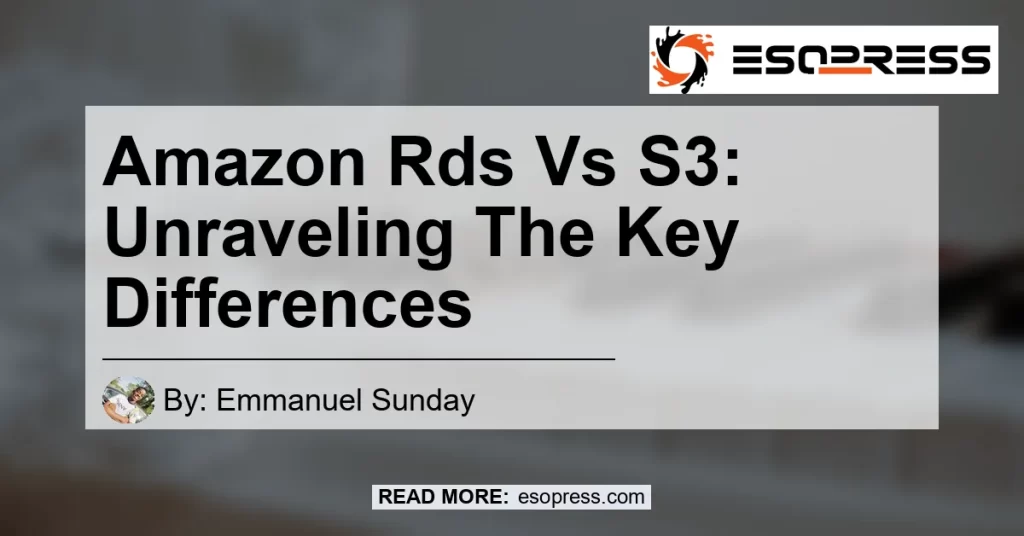

In the world of cloud computing, Amazon Web Services (AWS) offers a wide range of services to cater to different needs and requirements. Two popular services provided by AWS are Amazon RDS (Relational Database Service) and Amazon S3 (Simple Storage Service).
While both services are designed to store and manage data in the cloud, there are critical differences between them that can greatly impact your decision when choosing the appropriate service for your business needs.
Check out this Youtube video: “AWS S3 Vs. DynamoDB Vs. RDS Aurora Vs. Redshift” to understand the key differences between Amazon RDS and Amazon S3, and make an informed decision for your hosting needs.
Contents
What is Amazon RDS?
Amazon RDS is a managed database service offered by AWS. It allows you to set up, operate, and scale a relational database in the cloud with ease. With Amazon RDS, you can choose from various database engines such as MySQL, PostgreSQL, Oracle, SQL Server, and MariaDB, making it highly versatile and compatible with different applications.
What is Amazon S3?
On the other hand, Amazon S3 is a cloud storage service that offers object storage for any amount of data. It is designed to provide durability, availability, and scalability for storing and retrieving data. Amazon S3 enables you to store and retrieve any amount of data from anywhere on the web, making it an ideal choice for data-intensive applications.
Critical Differences: Consistency and Use Cases
When comparing Amazon RDS and Amazon S3, one critical difference is their consistency capabilities. While S3 is strongly consistent, its consistency is limited to single storage operations.
On the other hand, RDS supports transactions, allowing for more complex operations and ensuring ACID (Atomicity, Consistency, Isolation, Durability) compliance for your data.
The choice between Amazon RDS and Amazon S3 largely depends on the use case and nature of your application. If your application requires frequent read and write operations with complex transactions, Amazon RDS would be the suitable choice.
On the other hand, if you need to store and retrieve large amounts of data without the need for complex transactions, Amazon S3 provides a scalable and cost-effective solution.
Pros and Cons: Amazon RDS
Let’s take a closer look at the pros and cons of Amazon RDS:
Pros:
- Managed service: Amazon RDS takes care of administrative tasks such as hardware provisioning, software patching, and database backups, allowing you to focus on your application development.
- Scalability: RDS allows you to easily scale your database resources up or down based on your application’s demands.
- Multi-AZ deployment: With Amazon RDS, you can set up a Multi-AZ (Availability Zone) deployment, providing high availability and automatic failover in the event of a hardware failure.
- Security: Amazon RDS offers built-in security features such as encryption at rest and in transit, helping to protect your data from unauthorized access.
Cons:
- Limited database engine options: While Amazon RDS supports multiple database engines, the available options may be limited compared to running the database engine on your own server.
- Costs: Using Amazon RDS may incur additional costs compared to running your own database server, especially for larger-scale deployments.
Pros and Cons: Amazon S3
Now, let’s explore the pros and cons of Amazon S3:
Pros:
- Durability and availability: Amazon S3 is designed to provide 99.999999999% (11 nines) durability and 99.99% availability for stored data, ensuring your data is highly reliable and accessible.
- Unlimited storage capacity: Amazon S3 offers virtually unlimited storage capacity, allowing you to store and retrieve large amounts of data without worrying about storage constraints.
- Cost-effective: Amazon S3 provides a pay-as-you-go pricing model, allowing you to pay only for the storage you use, making it a cost-effective solution for storing large amounts of data.
Cons:
- Eventual consistency: While Amazon S3 offers strong consistency within a single storage operation, it provides eventual consistency for certain operations such as overwrite PUTS and DELETE operations, which means you might experience some delay in seeing the most up-to-date version of your data in rare cases.
Conclusion: Our Recommended Product
After careful consideration and analysis of the critical differences between Amazon RDS and Amazon S3, our recommended product for businesses looking for a powerful and scalable database solution is Amazon RDS. With its support for transactions and a wide range of database engines, Amazon RDS offers the flexibility and reliability needed for complex applications.
You can find the highly recommended Amazon RDS service here.


Remember to choose the service that aligns with your specific use case and requirements. Both Amazon RDS and Amazon S3 are powerful cloud services offered by AWS, and your decision should ultimately depend on your unique business needs.
Thank you for reading our comprehensive comparison of Amazon RDS and Amazon S3. We hope this article has provided valuable insights to help you make an informed decision.






